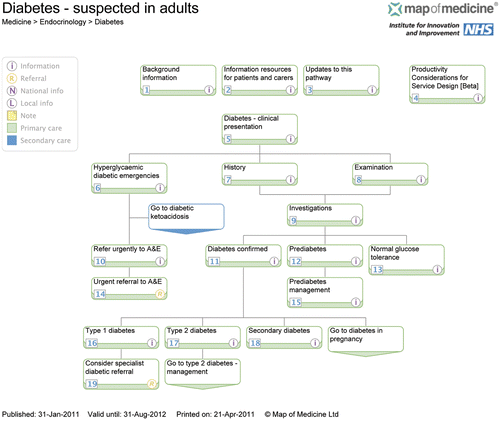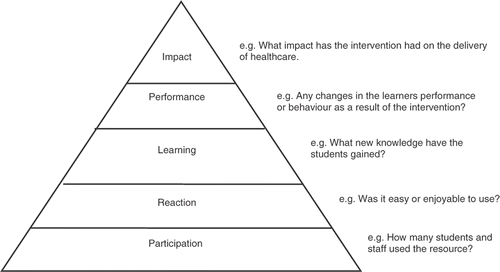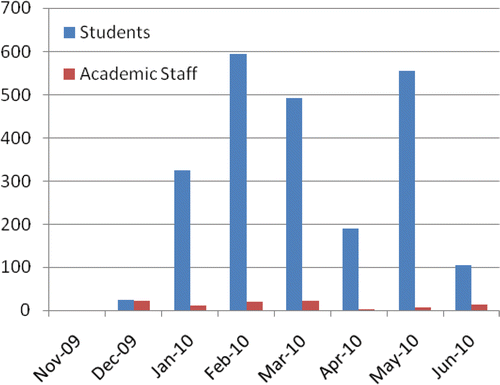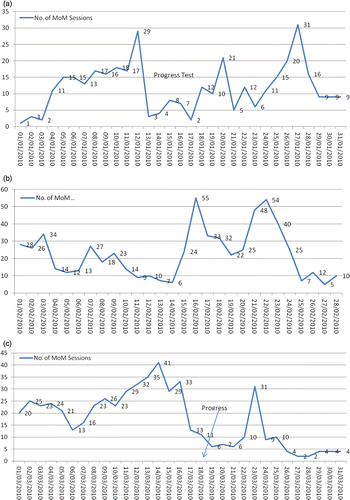Abstract
Background: Map of Medicine is a web-based knowledge resource depicting evidence-based pathways of patient care. Recent publications suggest a possible role for the Map of Medicine as a training tool in postgraduate education.
Aim: The aim of this study was to explore the potential of the Map of Medicine to enhance undergraduate medical education.
Methods: A mixed-method study including a survey of UK medical schools, and the embedding of the resource at one medical school and the evaluation of its impact.
Results: The survey found that only 1 of 23 medical schools was using the Map of Medicine in its undergraduate curriculum. The Peninsula Medical School students’ reaction to the resource was extremely positive. Students liked the Map of Medicine's navigability and help in accessing reliable information. Use of the resource by students grew steadily throughout the period of the study and peaked at 595 sessions a month. There was evidence that usage was directly linked to curricular events, particularly problem-based learning tutorials and medical knowledge assessments.
Conclusion: There is clear potential for the Map of Medicine in undergraduate medical education and a short-active period of resource promotion led to its embedding within routine learning practice.
Introduction
Evidence-based medicine ‘is the use of mathematical estimates of the risk of benefit and harm, derived from high-quality research on population samples, to inform clinical decision making in the diagnosis, investigation or management of individual patients’ (Greenhalgh Citation2006). An understanding of evidence-based medicine and how to implement it in practice has become an essential requirement for all professionals involved in the delivery of healthcare (Hayward Medical Communications Citation2010). There are a vast range of electronic resources available to support evidence-based practice in the UK including the National Library of Guidelines (http://www.library.nhs.uk/guidelinesFinder/), Clinical Knowledge Summaries (http://www.cks.nhs.uk/home) and the Map of Medicine (www.mapofmedicine.com).
The Map of Medicine is a web-based knowledge resource depicting evidence-based pathways of patient care for common and important medical conditions. It presents medical pathways of care as ‘decision trees’ that indicate Primary and Secondary Care roles in optimal disease management (). This provides an overview of medical care that can provide several useful functions including supporting clinical decision making and service redesign. In the UK, the Map of Medicine has been procured by the National Health Service (NHS) Connecting for Health programme and is available to all NHS staff via NHS Athens (NHS Connecting for Health Citation2010). Athens is an Access Management System that manages access to the electronic resources the NHS commissioned.
Recent publications suggest a possible role for the Map of Medicine as a training tool. When asked to indicate where the Map of Medicine might make most impact, senior hospital doctors felt it had significant potential as a knowledge resource for training (Map of Medicine Citation2007a). Similarly, a pilot study of the use of mobile Map of Medicine designed specifically for Personal Digital Assistants, smart phones and tablet PC's, by 20 clinicians in their day-to-day practice, demonstrated its potential within formal clinical training and the early stages of a clinical career (Map of Medicine Citation2007b). The study included general practitioners, emergency care practitioners, a group of junior hospital doctors and community-based nurses situated in rural dispensaries. However, there is no empirical evidence to suggest that the Map of Medicine has a role within undergraduate medical education. It is not known to what extent medical schools are already incorporating this resource within their programmes and, if so, whether it has had a beneficial impact.
Recognising the potential value of the Map of Medicine to enhance undergraduate education, the South West Strategic Health Authority, successfully applied for funding to carry out a collaborative study with the Peninsula Medical school, investigating amongst other things (Brennan et al. Citation2011), embedding the Map of Medicine resource within undergraduate medical curricula. The perceived benefits included providing an evidence-based framework for different medical conditions, contextualising student learning to the NHS setting and thus providing an authentic clinical experience, and embedding the use of evidence-based medicine in future clinical practice. This study set out to explore the potential of the Map of Medicine to enhance undergraduate medical education.
Methods
Survey of UK medical schools
A survey methodology was adopted to investigate the use of Map of Medicine by medical schools in the UK. In October 2009, an e-mail was sent to the nominated primary contact for each medical school listed on the Higher Education (HE) Academy website, asking whether the Map of Medicine was used in their undergraduate programme. A total of 23 out of the 31 medical schools responded (74% response rate).
Implementation at one medical school and evaluation of impact
Setting
The Peninsula Medical School undergraduate curriculum was used as a test site to explore the potential of the Map of Medicine within undergraduate medical education. The Peninsula Medical School is based on the South West of England and has a 5-year integrated curriculum featuring small group learning, including problem-based learning (PBL) in the first 2 years. A strong emphasis is placed by the school on early clinical exposure and students have clinical and community placements from their first week of medical school continuing to their final year. The study was carried out in the 2009/2010 academic year during which there were a total of 963 students across all 5 years.
Access
The Map of Medicine is licensed by the NHS and is accessed via NHS Athens. A patient version of the resource known as Healthguides is freely available via NHS Choices (NHS Connecting for Health Citation2010). While the Healthguides look the same as the Map of Medicine and hold the same generic pathways, they do not show localised pathways or have live links to other resources (e.g. the British National Formulary, Google and purchased information resources accessible through NHS Evidence).
The authors felt that for an optimal investigation of potential, medical students needed to have access to the NHS licensed version of Map of Medicine as it would be more authentic to medical practice and would familiarise students with a resource that they may use as qualified doctors. Third-, fourth- and fifth-year healthcare students, while on placement or attachment with an NHS organisation in England can already register for Map of Medicine from an NHS computer. However, first- and second-year students, and non-NHS staff cannot. Access to the NHS licensed version of the Map of Medicine was kindly given by the Map of Medicine company to all Peninsula Medical School staff and students for this study. The resource was made available through the Peninsula Medical School managed learning environment (EMILY) and required HE Athens passwords to log on.
Implementation
The resource was introduced to both clinical and non-clinical teachers, and students between September 2009 and March 2010. Teaching staff were given a 5-min demonstration of the resource's key features by the first author and their feedback about the unpredicted potential benefits in using the resource within their teaching was sought. The resource was also introduced to 60 teaching staff at the annual in-house education conference. If the resource was deemed beneficial by the teachers, then they were able to introduce it in their teaching sessions in whatever way they saw fit. Thus, the resource was sometimes introduced to students by their teachers. In addition, it was introduced to some groups of students directly by the first author using the same format but asking about its potential in their learning (rather than teaching).
When full access to the resource was gained in December 2009, an e-mail was sent to all students and teaching staff to inform them that the Map of Medicine was available via EMILY. Staff were also informed via a weekly newsletter. Relevant parts of EMILY were populated with links to the resource and to specific pathways e.g. the obesity PBL case was linked to the obesity pathway on the Map of Medicine. The key areas of the curriculum that incorporated the Map of Medicine were PBL (Years 1 and 2), special study units (Year 1) and evidence-based practice (Years 1 and 2). Years 1 and 2 students had not had access to the resource prior to this study and were thus of particular interest. In all areas of the curriculum, the Map of Medicine was presented to students as an additional learning resource in their self-directed learning but its use was recommended and was not compulsory.
Evaluation
The evaluation framework outlined by Kirkpatrick (Citation1998) in the 1950s and later adapted to medical education by Harden et al. (Citation1999) was used to evaluate the Map of Medicines’ potential in undergraduate education (). The first two levels (participation and reaction) were the focus for this study. Participation data on the level of usage of the Map of Medicine by Peninsula Medical School staff and students were gained from the Map of Medicine company. The data provided information on the number of Map of Medicine sessions, the top 10 pathways accessed and the user activity. It was only possible to get these data for the Peninsula level, which includes the Peninsula Medical School and three other NHS organisationsFootnote1. It was possible to distinguish between the Peninsula Medical School and the other NHS organisations for some of the data but not all.
Reaction data were generated when the Map of Medicine was introduced to staff and students, as detailed notes of the discussion and feedback were recorded. In addition, the lead researcher met with groups of students to evaluate their experience of using the resource and sought verbal and e-mail feedback about how students were using the Map within their studies. The data were subjected to thematic analysis.
The study also engages in process evaluation by providing information that allows other medical schools or healthcare educational institutions to replicate the study, particularly in terms of how to gain access to the Map of Medicine and how to embed it and promote it in the curriculum (Ruiz et al. Citation2006).
Results
Survey of UK medical schools
The survey found that only 1 of the 23 medical schools that responded to the questionnaire actively used the Map of Medicine in their undergraduate curriculum. At that school, the resource was introduced to their third-year students during an introductory course on information skills. Two medicals school indicated they were thinking of incorporating it in the future. One of the medical schools was prompted to look at the resource by our survey and reported it to be a potentially useful resource. One medical school had been approached by their Strategic Health Authority about using the resource.
Evaluating the impact at Peninsula Medical School
Participation – student and staff usage
Student use of the Map of Medicine increased from no access to the resource via HE Athens in November 2009 to 557 sessions in May 2010 (). Years 3–5 students may have used the resource via NHS Athens, while on a clinical placement although we have anecdotal reason to suspect this was infrequent. Usage declined to 190 and 105 sessions in April and June, respectively, which most likely relates to the Easter Holidays (29 March–12 April) and Summer Holidays (which started between 12 and 29 June depending on the year of the programme students were in). Staff usage remained low throughout the time period.
The most viewed pathways on the Map of Medicine between January and March Citation2010 by medical students Years 1–5 and staff () showed a strong correlation with the PBL cases studied in the same time period ().
Figure 4. Top 10 Pathways at Peninsula Level – Cumulative Usage from January 2010 to March 2010*. *While these data are for the Peninsula level, PMS staff and Years 1–5 students accounted for an average of 96% of usage over this time period.

Table 1. Topics covered in Years 1 and 2 PBL case units at the Peninsula Medical School – January–March 2010
There were peaks and troughs in the level of usage of the Map of Medicine over time () and these seemed to coincide with curricular activities in PBL sessions and assessment. This suggests that the Map of Medicine was used partly in preparation for the progress tests which were held on 14 January and 18 March 2010. The peak of activity is 2 or 3 days prior to the progress test.
Reaction – student and staff perceptions and feedback
Students’ reactions were largely positive to the resource, while feedback from staff was mixed. The thematic analysis identified four main themes (illustrative data are presented in ). The most dominant theme was ‘accessing reliable information’. Students and staff found the resource useful for accessing reliable evidence-based information. Another important theme identified was ‘pathway format/ease of use’. Staff and students liked the pathway format and the fact that the resource was easy to use.
Table 2. Findings of thematic analysis of staff and student feedback
Discussion
The usage figures combined with the qualitative feedback indicate that there is a significant appetite for access to the Map of Medicine amongst medical students. Students commented on its navigability and help in accessing reliable information quickly. Furthermore, the fact that students were still using the resource 5 months after hearing about it and were making repeat visits to the resource provides an active endorsement.
Pathways that were viewed by students in the study period seemed to be temporally linked to events in the undergraduate curriculum. There was a strong correlation in terms of what was being covered in the different case units in PBL in Years 1 and 2. However, we do not know why the top pathway ‘abnormal bleeding’ had a large amount of usage access compared to other pathways. Similarly, there appeared to be higher usage of the Map of Medicine just before an assessment of applied medical knowledge. Other studies have reported similar findings (McNulty et al. 2000; Hardy et al. Citation2005).
While some staff perceived the Map of Medicine as beneficial, particularly for student's self-directed learning, others remained unconvinced. There were questions as to how this resource was different to the numerous other resources available, for example the Clinical Knowledge Summaries (also available on NHS Athens). There was also an initial fear amongst PBL tutors that it may negate the PBL process with first-year students. An important part of the PBL process is students learning how to find different sources of information and critically appraising the information they find (Das et al. Citation1998). Tutors felt that if students were introduced to the Map of Medicine, which has reliable information that is already critically appraised and graded, that students would not look for further information and would just regurgitate what the Map of Medicine says on a particular topic. However, other tutors thought the Map of Medicine motivated learning through its authenticity to clinical practice, was a good starting point for a student's research, and enabled them to spend more time on the most important information.
Rowley and Urquhart (Citation2007) report that in terms of student's use of electronic resources there is little evidence on the effectiveness of promotional strategies. This study provides evidence that an active period of resource promotion can lead to a new resource being successfully adopted in students’ routine learning practice. Furthermore, the process evaluation approach detailing how access to the resource was gained, how it was embedded in the curriculum and how it was actively promoted provides a model that other medical schools could replicate (Ruiz et al. Citation2006).
The strength of the intervention (access to the Map of Medicine) was its authenticity to clinical practice and its potential to stimulate and support the development of evidence-based practice in medical students. The strength of the evaluation was its combination of quantitative and qualitative data, with usage data providing an objective measure of student uptake and the qualitative data enriching our understanding of how the resource might be used by students. A limitation of the study is that we were unable to make links between uptake of the resource and assessment outcomes, primarily due to the breadth of information that might be accessed via the Map of Medicine. A second limitation is that the resource was introduced and evaluated at a single setting and the processes involved and student reactions to the intervention might well be different elsewhere.
Clearly, encouraging medical students to use evidence-based resources is only the first step. Whether becoming familiar with information resources as an undergraduate means that the same resources will be used within clinical practice remains to be seen. Similarly, whether the use of high-quality information resources by clinicians contributes to better clinical outcomes is not well established. Despite this need for further research, we believe our study is important in establishing the clear potential for the Map of Medicine within undergraduate medical education.
When this study was conducted access to the Map of Medicine was restricted to NHS staff by NHS Athens. However, driven by the findings of this study the Map of Medicine has been made freely available to all medical students in the UK via their HE Athens account (Map of Medicine Citation2010). Medical schools looking to enable access to the Map of Medicine for their organisation free of charge should login to the Map via their Athens account or contact [email protected].
Acknowledgement
The authors would like to acknowledge the help and support of Tricia Ellis and Caroline Squires.
Declaration of interest: The authors report no conflicts of interest. The authors alone are responsible for the content and writing of the article.
Notes
1. Peninsula Cancer Network, South Western Ambulance Service, Peninsula Cardiac Network and Devon Partnership Trust.
References
- Brennan N, Mattick K, Ellis T. The Map of Medicine: A review of evidence for its impact on healthcare. Health Info Libr J 2011; 28: 93–100
- Das M, Mpofu D, Dunn E, Lanphear JH. Self and tutor evaluations in problem-based learning tutorials: Is there a relationship?. Med Educ 1998; 32: 411–418
- Greenhalgh T. How to read a paper: The basics of evidence-based medicine. Blackwell Publishing, Oxford 2006
- Harden R, Grant J, Buckley G, Hart IR. BEME Guide No. 1: Best evidence medical education. Med Teach 1999; 21: 553–562
- Hardy J, Bates S, Antoniletti M, Seed T, 2005. Integrating e-learning and on-campus teaching II: Evaluation of student use. [Accessed 2010 October 7]. Available from: www.ph.ed.ac.uk/elearning/publications/hardyaltc2005-v2.doc
- Hayward Medical Communications. Evidence-based medicine. Hayward Medical Communications, London 2010
- Kirkpatrick D. Evaluating training programmes. Berrett-Koehler, San Francisco 1998
- Map of Medicine 2010. “Map of Medicine now freely available to students.” [Retrieved 2011 April 20]. Available from: http://www.mapofmedicine.com/newsandevents/news/2010/students
- Map of Medicine 2007a. Map of Medicine rated highly as a valuable knowledge resource. The Pathway – Map of Medicine Newsletter, 4
- Map of Medicine 2007b. The Mobile Map of Medicine pilot studies. The Pathway – Map of Medicine Newsletter, 2
- Mcnulty JA, Halama J, Dauzvardis MF, Espiritu B. Evaluation of web-based computer-aided instruction in a basic science course. Acad Med 2000; 75: 59–65
- NHS Connecting for Health 2010., Map of Medicine. [Accessed 2010 July 28]. Available from: http://www.connectingforhealth.nhs.uk/systemsandservices/mapmed
- Rowley J, Urquhart C. Understanding student information behaviour in relation to electronic information services: Lessons from longitudinal monitoring and evaluation, Part 1. J Am Soc Inform Sci Technol 2007; 58: 1162–1174
- Ruiz JG, Mintzer MJ, Leipzig RM. The impact of e-learning in medical education. Acad Med 2006; 81: 207–212




